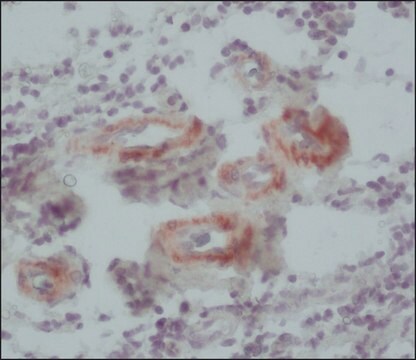MAB5328
Anti-RAGE Antibody, clone DD/A11 or A11
Chemicon®, from mouse
Synonym(s):
Receptor for Advanced Glycosylation End Products.
About This Item
Recommended Products
biological source
mouse
Quality Level
antibody form
purified antibody
antibody product type
primary antibodies
clone
DD/A11, monoclonal
mAbA11, monoclonal
species reactivity
human, bovine, mouse
species reactivity (predicted by homology)
rat
manufacturer/tradename
Chemicon®
technique(s)
ELISA: suitable
immunocytochemistry: suitable
immunohistochemistry: suitable
western blot: suitable
isotype
IgG2a
NCBI accession no.
UniProt accession no.
shipped in
wet ice
target post-translational modification
glycosylation
Gene Information
human ... AGER(177)
General description
Specificity
Immunogen
Application
A previous lot of this antibody was shown to be reactive on paraffin embedded tissue sections.
Immunocytochemistry:
A previous lot was shown to work on cells fixed with ice cold acetone using a Cy3 conjugated secondary antibody.
ELISA:
A previous lot was shown to work on direct ELISA.
Immunoblotting:
Recognizes a band of ~48kDa in bovine lung extract.
Optimal working dilutions must be determined by end user.
Quality
Western Blot:
1:500 dilution of this lot detected RAGE on 10 μg of Mouse Brain lysates.
Target description
Physical form
Analysis Note
Lung tissue, mouse brain lysate.
Other Notes
Legal Information
Not finding the right product?
Try our Product Selector Tool.
Storage Class
10 - Combustible liquids
wgk_germany
WGK 2
flash_point_f
Not applicable
flash_point_c
Not applicable
Certificates of Analysis (COA)
Search for Certificates of Analysis (COA) by entering the products Lot/Batch Number. Lot and Batch Numbers can be found on a product’s label following the words ‘Lot’ or ‘Batch’.
Already Own This Product?
Find documentation for the products that you have recently purchased in the Document Library.
Our team of scientists has experience in all areas of research including Life Science, Material Science, Chemical Synthesis, Chromatography, Analytical and many others.
Contact Technical Service